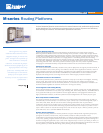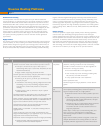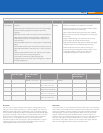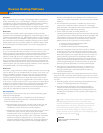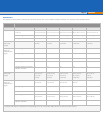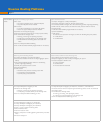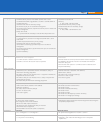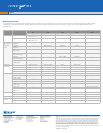
Page 4
M-series Routing Platforms
M20 Router
Only 14 inches (35.56 cm) in height, the M20 design delivers increased port
density, performance of 20+ Gbps throughput, scalability, and reliability in a
space-efficient package. The M20 offers fully redundant hardware, including
redundant switching fabrics and Routing Engines to increase system
availability. The M20 supports 16 PICs and up to OC-48/STM-16 uplink speeds
in a compact package ideal for the provider edge in medium and large PoPs.
M40e Router
The M40e router provides a dense, highly redundant platform primarily
targeted for dense dedicated access aggregation and provider edge services in
medium and large POPs. This 40+ Gbps platform supports 32 ejector-enabled
PICs via 8 FPCs and up to OC-48/STM-16 uplink speeds in a half-rack package.
The M40e offers common hardware redundancy including the switch fabrics,
Routing Engines, fan trays, and power supplies. This platform supports M160
PICs and many PICs are forward-portable to the T-series routing platforms.
M160 Router
The M160 router offers up to 8 OC-192c/STM-64 PICs per chassis (16 per rack)
or up to 32 OC-48c/STM-16 PICs per chassis (64 per rack) with up to 160+
Gbps throughput. The M160 platform is ideal for medium-sized backbone cores
requiring predictable performance for feature-rich infrastructures and also
supports provider edge services in 10-gigabits POPs. In addition, this platform
is ideal where switching fabric and Routing Engine redundancy are required. All
major components are field replaceable, increasing system serviceability and
reliability, and decreasing mean time to repair. For investment protection and
smooth migration path, this platform supports M40e PICs. As well, many PICs
are forward-portable to the T-series routing platforms.
M320 Router
The M320 is a high performance, 10Gbps-capable, distributed architecture edge
router. It offers up to 16 OC-192c/STM-64 PICs per chassis (32 per rack) or up
to 64 OC-48c/STM-16 ports per chassis (128 per rack) with up to 320 Gbps
throughput. The M320 platform is ideal for medium-sized backbone cores
requiring predictable performance for feature-rich infrastructures and also
supports provider edge services in 10-gigabit POPs with the ability to support
up to 32 type 1 and type 2 PICs and up to 16 type 3 PICs for 10 Gbps uplinks.
In addition, this platform is ideal where switching fabric and Routing Engine
redundancy are required. All major components are field replaceable,
increasing system serviceability and reliability, and decreasing mean time to
repair. PICs are compatible with M40e, M160, T320, and T640.
Key Components
Key components of each M-series router are the Packet Forwarding Engine
(PFE) and the Routing Engine.
• The PFE is a logical entity that is responsible for packet forwarding. It
physically consists of the PICs, FPCs, FIC, control/system/forwarding
board, and state-of-the-art ASICs
• Physical Interface Cards provide a complete range of fiber optic and
electrical transmission interfaces to the network. For a listing of
available PICs, see the M-series PICs and FPCs datasheet.
• Flexible PIC Concentrators house PICs and connect them to the rest of
the PFE. FPCs parse, prioritize, and queue the packets before
forwarding them across the midplane to the appropriate destination
interface. On egress, FPCs prioritize, queue, re-assemble, and forward
packets out through the appropriate port. Up to four PICs can be
mixed and matched within a single FPC slot, increasing configuration
flexibility and network scalability, while maximizing POP efficiency.
The FPC required depends on the platform and on the PICs that are
needed. For a listing of available FPCs, see the M-series PICs and FPCs
datasheet.
• The Fixed Interface Concentrator is available only on the M7i and
contains either 2 fixed Fast Ethernet interfaces or 1 fixed Gigabit
Ethernet Interface. The Gigabit Ethernet interface requires Small Form
factor Pluggable optics (SFP ordered separately).
• On M7i, M10i, M20, M40e, and M160 platforms, the
control/system/forwarding board performs route lookup and switching
to the destination FPC. It makes forwarding decisions, distributes data
cells throughout memory, processes exception and control packets,
monitors system components, and controls FPC resets. There are
different names for this component on various platforms:
• M7i/M10i Compact Forwarding Engine Board
• M20 System and Switch Board
• M40e/M160 Switching and Forwarding Module
• M320 uses a distributed architecture, where the PFE is contained
entirely within the FPC. Route lookup and packet processing occurs
on the ingress PFE, and is then switched across the Switch Interface
Board (switching fabric) to the egress PFE for final route lookup and
packet processing. The feature-rich programmable ASICs deliver a
comprehensive, hardware-based system for packet processing and
support uncompromising 40 Gbps performance per PFE. To ensure a
non-blocking forwarding path, all channels between the ASICs and
between ingress and egress PFEs are oversized, dedicated paths.
• The feature-rich programmable ASICs deliver a comprehensive,
hardware-based system for packet processing. To ensure a non-
blocking forwarding path, all channels between the ASICs are
oversized, dedicated paths.
• The Routing Engine maintains the routing tables and controls the routing
protocols, as well as the JUNOS software processes that control the router's
interfaces, the chassis components, system management, and user access to
the router
• The Routing Engine processes all routing protocol updates from the
network, so forwarding performance is not affected.
• The Routing Engine implements each routing protocol with a
complete set of Internet features and provides full flexibility for
advertising, filtering, and modifying routes. Routing policies are set
according to route parameters, such as prefixes, prefix lengths, and
BGP attributes.
Cable & Wireless will provision new IP capabilities over
both dedicated high-speed access lines and lower speed
consumer broadband services using Juniper Networks MPLS-
based infrastructure. The delivery of multiple, concurrent IP
services will have a positive impact on our total cost of
ownership and ultimately simplify our network operations.
Juniper Networks M-series infrastructure will intelligently speed
IP traffic through our network.
Phil Green
Senior Vice President, Global Operations
Cable & Wireless
“
“



